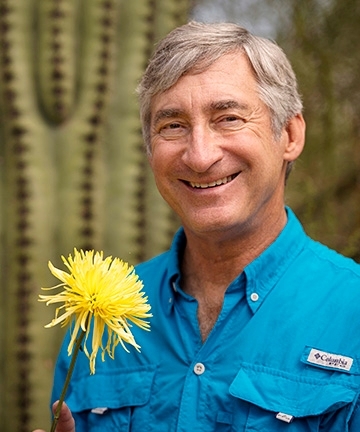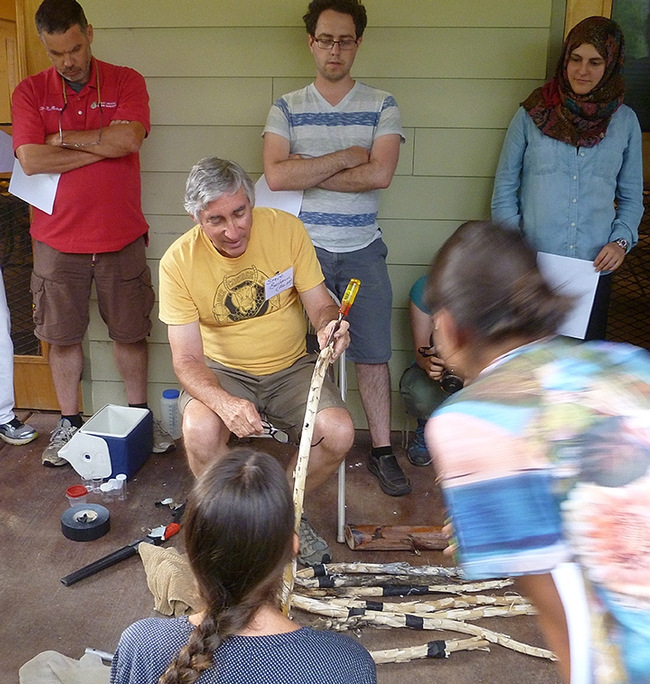
The UC Davis-trained entomologist, author of the newly published paperback book, The Reason for Flowers: Their History, Culture, Biology, and How They Change Our Lives, "has been on the cutting edge of many areas of pollination biology," said Robbin Thorp, distinguished emeritus professor of entomology at UC Davis who served as his major professor. Buchmann, who received his doctorate in entomology from UC Davis in 1978, is a researcher and adjunct professor in the departments of entomology and ecology and evolutionary biology at the University of Arizona, Tucson.
"Steve jumps onto new ideas with great enthusiasm and explores them in depth," Thorp said. "He has been a leader in areas like buzz pollination, the contribution of electrostatics in pollen harvesting by bees, and adaptations in bees that collect oils from specialized flowers. He raised important issues about the conservation of bees in co-authoring the benchmark book, The Forgotten Pollinators, a decade before colony collapse disorder (CCD) in honey bees captured the attention of the media and general public."

Thorp and Buchmann are among the instructors at The Bee Course, which attracts conservation biologists, pollination ecologists and other attendees from all over the world. It's affiliated with the American Museum of Natural History.
So last year when Simon & Schuster published Buchmann's latest book, Reason for Flowers, it drew quite a splash. Bee scientists and bee enthusiasts, teachers and students, and lovers of flowers and just plain lovers, grabbed copies of the book, which, as of Feb. 9, is now in paperback. National Public Radio (NPR) interviewed him.
One word immediately grabbed everyone's attention: "sex."
"The reason for flowers is actually one word: sex," Buchmann told NPR's Arun Rath. "So, flowers are literally living scented billboards that are advertising for sexual favors, whether those are from bees, flies, beetles, butterflies or us, because quite frankly most of the flowers in the world have gotten us to do their bidding. But that's only the first stage because flowers, if they're lucky, turn into fruits, and those fruits and seeds feed the world."
A scientist who seemingly never sleeps, Buchmann has published more than 150 scientific articles and 11 popular nonfiction books, including The Forgotten Pollinators (a Los Angeles Times Book Prize finalist) with Gary Nabhan. His book, Honey Bees: Letters from the Hive, is a National Science Teachers' Association Outstanding Science Trade Book. He's also written a children's book The Bee Tree (with Diana Cohn), described as the true story of a family of honey hunters in peninsular Malaysia.
So, we asked Buchmann to provide "10 reasons for flowers." He provides greater detail in his book, but here are 10 reasons:
- Flowers Feed The World. Because pollinated and fertilized blossoms turn into nutritious fruits and seeds, these invaluable foodstuffs keep the world's 7.2 billion people from starvation. These resulting fruits also feed birds, bears and other wildlife.
- Tasty and Nutritious. Although the calories from starchy cereals and grain crops feed the world, we enjoy and need the “nutraceuticals” and antioxidants inside colorful cranberries, blueberries, oranges and apples. They keep us healthy and happy.
- Edible flowers. Some flowers (e.g. roses, some marigolds) are great as edible garnish and foods. Find out which ones can be eaten and what they taste like.
- Humans might never have evolved, or survived. Early hominids certainly recognized that flowers were the harbingers of tasty fruits. Without flowers, perhaps no people today.
- Flowers make us smile. Give someone a flower(s) and they flash a genuine Duchenne smile. Rutgers psychologist Dr. Jeanette Haviland-Jones has infused subliminal amounts of rose and gardenia vs. manmade scents into room air. Subjects use more enjoyment words and were more likely to approach or touch a stranger when the floral scents were present. Flowers may counteract the semiochemicals for fear, anger and anxiety that humans seem to constantly be emitting.
- 200 million red roses! Americans buy about 10 million cut blooms every day. On Valentine's Day that can jump to 200 million cut flowers, especially red roses. Most of these flowers are grown in Columbia and Ecuador then arrive in the bellies of jumbo jets arriving at the Miami airport.
- As costly as gold. Saffron is the world's costliest spice and the subject of countless fake imitations. The spice is the dried styles from crocus blooms. Hand-picking and the fact that this represents such a tiny fraction of the entire plant, make it so costly and precious.
- For inspiration and romance. Flowers have inspired generations of poets, writers and artists. Their myriad shapes, colors and scents enrich our lives with beauty. Their sexuality and alluring scents bring romance into our lives.
- Most ancient. The world's earliest known flower is the 8-inch tall fossil Achaefructus that grew in China 130-160 million years ago. Turns out that these and other early blooms were puny runts. They wouldn't win best of show ribbons in any flower show.
- Flowers in the service of science. Without Gregor Mendel's crossing experiments with the humble garden pea, we wouldn't have learned about the laws of inheritance when we did.
So, flowers feed the world, keep us healthy and make us smile. What could be better than that?
Attached Images:
